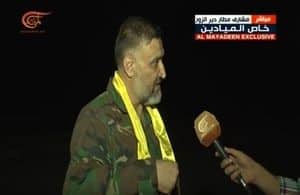
After pro-Syrian regime forces broke the siege of Deir Ezzor city this month, Lebanese Hezbollah media outlet Al Mayadeen released a rare interview with Hezbollah field commander “al Haj Abu Mustafa,” crediting the gray-haired, southern Lebanese native with playing a key role in leading the defense against the Islamic State.
The revelation highlights the instrumental roles of both Hezbollah and Iran’s Islamic Revolutionary Guard Corps (IRGC) – backed by Russian air power – in crucial military victories for Syrian President Bashar al Assad. It also reflects an attempt by Hezbollah and the IRGC to shape the media narrative after their images have suffered this past month following a controversial deal to evacuate Islamic State fighters from their enclave in Lebanon to eastern Syria by the Iraqi border.
Before last week, the Sunni jihadists had besieged Deir Ezzor and the 137th Mechanized Army Base since July 2014. “A prominent commander of the resistance” – likely Abu Mustafa – arrived in Deir Ezzor in June 2016 to evaluate the situation on the ground in preparation for a military operation to lift the siege, according to an IRGC-affiliated media outlet. At the time, “resistance leaders” pushed to delay that operation until after the full conquer of Aleppo city. The article states Abu Mustafa was helping plan the defense of Deir Ezzor in November 2016. The following month, the pro-regime alliance succeeded in fully subduing Aleppo after a months-long bloody battle. Then, in January, the Islamic State cut the regime-held area in Deir Ezzor city in half, separating the military airport and tightening the siege. Abu Mustafa had a “prominent role” in defending the airport. The besieged forces had to wait nine months before reinforcements would arrive.
Before committing forces to a large-scale assault to reach Deir Ezzor, pro-regime forces had to first freeze the fighting against insurgent pockets in western Syria. The jihadist-led offensives in Hama and Damascus that began in March highlighted the fact that the pro-regime forces lacked the manpower to fully commit to both fronts. An offensive deep into the so-called caliphate would surely require a full commitment of resources. Russia played a crucial role in negotiating safe zones in western Syria, thus securing that front.
For the past several months, pro-regime forces have launched offensives from both the north and central Syria to reach Deir Ezzor. Participating forces have included Russian air and ground forces, Iranian-led Shiite militias such as Lebanese Hezbollah, pro-Assad Syrian militias such as the elite Tiger Forces, and the Syrian Arab Army, a shadow of its former self (see FDD’s Long War Journal report, Analysis: The Syrian regime’s offensive towards Deir Ezzor).
This month, the alliance reached Deir Ezzor, a milestone for the regime. Hezbollah and its allies held parades and hoisted their flags (see FDD’s Long War Journal report, IRGC-led Afghan militiamen hoist flags in Deir Ezzor city).
Last week, Hezbollah unveiled Abu Mustafa, who has commanded its forces in the city, according to IRGC-affiliated media outlets. He says Hezbollah chief Hassan Nasrallah signed off on the interview, underscoring the importance of going public.
Abu Mustafa credited the “unity” of “all forces in the city” for withstanding the months-long siege. He said the victory would not have been possible without the Iran-Russia-Syria alliance.
“Hezbollah is the inseparable part of an axis that stretches from Iran to Syria and occupied Palestine,” said Abu Mustafa.
Hezbollah’s deputy Secretary General, Maim Qassim, later said in a televised interview, “We wanted to say with the message of brother Abu Mustafa that we are part of the equation in the region, and Hezbollah is like a main partner in Lebanon’s victory.”
IRGC-affiliated outlet Mashregh News has published a detailed analysis of why Hezbollah chose to break protocol and reveal the field commander’s identity.
“Hezbollah’s media game has changed,” Mashregh News reported. “He [Abu Mustafa] may have been martyred in a far away area after several years, and it would have been at that time that limited material would have been written about Deir Ezzor in a biography. But today, he is talking about an immediate event. In the war for the future of the region, we want to make public awareness a fundamental part of that war.”
The article called the revelation part of a concerted media strategy by “the resistance” to counter an alleged information campaign waged by “the American axis” to “damage and destroy” the “role of the resistance.” The article cited the controversy over last month’s Hezbollah agreement with the Islamic State to evacuate the latter’s forces from eastern Lebanon to Abu Kamal in eastern Syria and by the Iraqi border. In exchange, the Islamic State was to release several captives and bodies of fighters including a beheaded Iranian officer who has become a poster boy for the IRGC. Washington and Baghdad condemned the deal, and the US launched air strikes to disrupt the convoy. Widespread segments of the Iraqi public decried Hezbollah and allies for dumping more jihadists on their doorstep. That damaged the public image of pro-Iranian Iraqi militias and figures. As usual, IRGC media try to cover for failures by blaming real and imagined US-led efforts.
Mashregh’s article claimed the supposed campaign to discredit Hezbollah and allies “forces the party to show more sides of the reality and the nature of its widespread role in Syria and Iraq against terrorist and takfiri groups.” It cited the battle for public opinion as “one of the needs of the post-DAESH [Islamic State] stage.”







